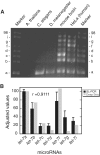Analysis of microRNA signatures using size-coded ligation-mediated PCR
- PMID: 21486750
- PMCID: PMC3130289
- DOI: 10.1093/nar/gkr214
Analysis of microRNA signatures using size-coded ligation-mediated PCR
Abstract
The expression pattern and regulatory functions of microRNAs (miRNAs) are intensively investigated in various tissues, cell types and disorders. Differential miRNA expression signatures have been revealed in healthy and unhealthy tissues using high-throughput profiling methods. For further analyses of miRNA signatures in biological samples, we describe here a simple and efficient method to detect multiple miRNAs simultaneously in total RNA. The size-coded ligation-mediated polymerase chain reaction (SL-PCR) method is based on size-coded DNA probe hybridization in solution, followed-by ligation, PCR amplification and gel fractionation. The new method shows quantitative and specific detection of miRNAs. We profiled miRNAs of the let-7 family in a number of organisms, tissues and cell types and the results correspond with their incidence in the genome and reported expression levels. Finally, SL-PCR detected let-7 expression changes in human embryonic stem cells as they differentiate to neuron and also in young and aged mice brain and bone marrow. We conclude that the method can efficiently reveal miRNA signatures in a range of biological samples.
Figures






Similar articles
-
Real-time polymerase chain reaction microRNA detection based on enzymatic stem-loop probes ligation.Anal Chem. 2009 Jul 1;81(13):5446-51. doi: 10.1021/ac900598d. Anal Chem. 2009. PMID: 19469541
-
Highly sensitive and specific multiplexed microRNA quantification using size-coded ligation chain reaction.Anal Chem. 2014 Jan 21;86(2):1076-82. doi: 10.1021/ac4026384. Epub 2014 Jan 2. Anal Chem. 2014. PMID: 24364819
-
A high-throughput method to monitor the expression of microRNA precursors.Nucleic Acids Res. 2004 Feb 25;32(4):e43. doi: 10.1093/nar/gnh040. Nucleic Acids Res. 2004. PMID: 14985473 Free PMC article.
-
Isothermal Amplification for MicroRNA Detection: From the Test Tube to the Cell.Acc Chem Res. 2017 Apr 18;50(4):1059-1068. doi: 10.1021/acs.accounts.7b00040. Epub 2017 Mar 29. Acc Chem Res. 2017. PMID: 28355077 Review.
-
In situ detection of precursor and mature microRNAs in paraffin embedded, formalin fixed tissues and cell preparations.Methods. 2008 Jan;44(1):39-46. doi: 10.1016/j.ymeth.2007.10.008. Methods. 2008. PMID: 18158131 Review.
Cited by
-
Nucleic Acids Analysis.Sci China Chem. 2021;64(2):171-203. doi: 10.1007/s11426-020-9864-7. Epub 2020 Dec 2. Sci China Chem. 2021. PMID: 33293939 Free PMC article. Review.
-
Universal stem-loop primer method for screening and quantification of microRNA.PLoS One. 2014 Dec 30;9(12):e115293. doi: 10.1371/journal.pone.0115293. eCollection 2014. PLoS One. 2014. PMID: 25548906 Free PMC article. Clinical Trial.
-
Multiplex quantitative analysis of microRNA expression via exponential isothermal amplification and conformation-sensitive DNA separation.Sci Rep. 2017 Sep 12;7(1):11396. doi: 10.1038/s41598-017-11895-6. Sci Rep. 2017. PMID: 28900270 Free PMC article.
-
Research progress in molecular biology related quantitative methods of MicroRNA.Am J Transl Res. 2020 Jul 15;12(7):3198-3211. eCollection 2020. Am J Transl Res. 2020. PMID: 32774694 Free PMC article. Review.
-
Novel microRNAs differentially expressed during aging in the mouse brain.PLoS One. 2012;7(7):e40028. doi: 10.1371/journal.pone.0040028. Epub 2012 Jul 23. PLoS One. 2012. PMID: 22844398 Free PMC article.
References
-
- Molnar A, Schwach F, Studholme DJ, Thuenemann EC, Baulcombe DC. miRNAs control gene expression in the single-cell alga Chlamydomonas reinhardtii. Nature. 2007;447:1126–1129. - PubMed
-
- Chaudhuri K, Chatterjee R. MicroRNA detection and target prediction: integration of computational and experimental approaches. DNA Cell. Biol. 2007;26:321–337. - PubMed
-
- Yoon S, De Micheli G. Computational identification of microRNAs and their targets. Birth Defects Res. C Embryo Today. 2006;78:118–128. - PubMed
-
- Windsor AJ, Mitchell-Olds T. Comparative genomics as a tool for gene discovery. Curr. Opin. Biotechnol. 2006;17:161–167. - PubMed
Publication types
MeSH terms
Substances
LinkOut - more resources
Full Text Sources
Other Literature Sources

